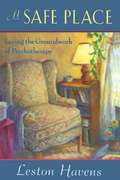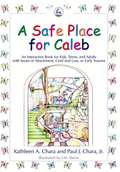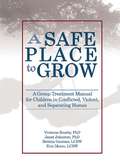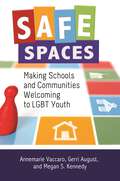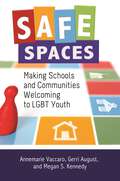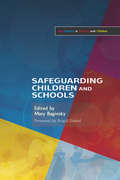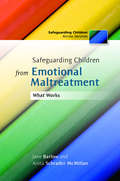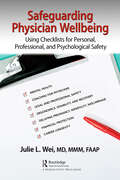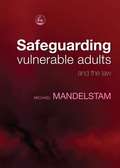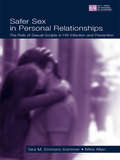- Table View
- List View
A Safe Place: Laying The Groundwork Of Psychotherapy
by Leston HavensDrawing on his rich experience within psychiatry, Leston Havens takes the reader on an extraordinary journey through the vast and changing landscape of psychotherapy and psychiatry today. Closely examining the dynamics of the doctor–patient exchange, he seeks to locate and describe the elusive therapeutic environment within which psychological healing most effectively takes place.
A Safe Place: Laying The Groundwork Of Psychotherapy
by Leston HavensDrawing on his rich experience within psychiatry, Leston Havens takes the reader on an extraordinary journey through the vast and changing landscape of psychotherapy and psychiatry today. Closely examining the dynamics of the doctor–patient exchange, he seeks to locate and describe the elusive therapeutic environment within which psychological healing most effectively takes place.
A Safe Place for Caleb: An Interactive Book for Kids, Teens and Adults with Issues of Attachment, Grief, Loss or Early Trauma (PDF)
by Jane M. Berns Kathleen A. Chara Paul J. CharaA Safe Place for Caleb is a comprehensive and richly illustrated resource for individuals of all ages who are dealing with attachment problems. Parents, professionals, and lay people will find this book helpful in understanding and addressing attachment disorders in children, adolescents, and adults. The first half of the book is an interactive story that follows the experiences of Caleb, a young boy who relates his difficulties and frustrations in forming and sustaining healthy relationships. He learns strategies for coping with attachment issues during his journey to the Safe Tree House, where he is introduced to the four 'attachment healing keys'. These act as therapeutic tools to unlock difficulties with attachment, and are presented using text and illustrations that are easily accessible for readers of all ages, even for young children. The second half of the book presents a summary of current scientific thought on attachment styles and disorders, and provides a wide array of assessment tools, photocopiable material and healing techniques to address attachment difficulties. Lists of helpful organizations and relevant reading materials are also presented. Based on established psychological principles, the book is a unique and imaginative guide for professionals, parents, caregivers, and people of all ages who are dealing with attachment issues.
A Safe Place for Caleb: An Interactive Book for Kids, Teens and Adults with Issues of Attachment, Grief, Loss or Early Trauma
by Kathleen A. Chara Jane M. Berns Paul J. CharaA Safe Place for Caleb is a comprehensive and richly illustrated resource for individuals of all ages who are dealing with attachment problems. Parents, professionals, and lay people will find this book helpful in understanding and addressing attachment disorders in children, adolescents, and adults. The first half of the book is an interactive story that follows the experiences of Caleb, a young boy who relates his difficulties and frustrations in forming and sustaining healthy relationships. He learns strategies for coping with attachment issues during his journey to the Safe Tree House, where he is introduced to the four 'attachment healing keys'. These act as therapeutic tools to unlock difficulties with attachment, and are presented using text and illustrations that are easily accessible for readers of all ages, even for young children. The second half of the book presents a summary of current scientific thought on attachment styles and disorders, and provides a wide array of assessment tools, photocopiable material and healing techniques to address attachment difficulties. Lists of helpful organizations and relevant reading materials are also presented. Based on established psychological principles, the book is a unique and imaginative guide for professionals, parents, caregivers, and people of all ages who are dealing with attachment issues.
A Safe Place to Grow: A Group Treatment Manual for Children in Conflicted, Violent, and Separating Homes
by Vivienne Roseby Janet Johnston Bettina Gentner Erin MooreDiscover the effective group treatment strategies that help your school-aged clients! A child immersed in a conflicted family life may be forced to cope with a multitude of trauma, including violence, abuse, and insecurity. In A Safe Place to Grow: A Group Treatment Manual for Children in Conflicted, Violent, and Separating Homes, highly respected experts give mental health professionals the tools to provide effective group treatment for children scarred by family environments of conflict and abuse. This easy-to-understand, step-by-step manual is a developmentally appropriate treatment curriculum for traumatized school-aged children. Age-appropriate sections separate therapy for big or little kids, focusing on efficacy while presenting a comfortable multi-ethnic, multi-cultural model. A Safe Place to Grow has easy-to-understand descriptions of techniques, with each session in the curriculum containing games and activities that are therapeutic yet flexible enough to be modified whenever the situation warrants. A chapter is included to helpfully troubleshoot problems encountered when in session with either age group of children. Useful illustrations accompany the text, along with a comprehensive bibliography listing additional therapeutic resources for different types of family problems. Appendixes are included for instruction on psycho-educational groups for parents that enhance their sensitivity to their children&’s needs, as well as providing an evaluation study of the group model itself.A Safe Place to Grow provides a sequence of activities within the group model aimed at each of these five goals: creating common ground and safety exploring the language and complexity of feeling defining and understanding the self defining and revising roles and relationships restoring a moral orderA Safe Place to Grow is an essential resource for social workers, psychologists, family and child therapists, school counselors, and battered women and children&’s advocates.
A Safe Place to Grow: A Group Treatment Manual for Children in Conflicted, Violent, and Separating Homes
by Vivienne Roseby Janet Johnston Bettina Gentner Erin MooreDiscover the effective group treatment strategies that help your school-aged clients! A child immersed in a conflicted family life may be forced to cope with a multitude of trauma, including violence, abuse, and insecurity. In A Safe Place to Grow: A Group Treatment Manual for Children in Conflicted, Violent, and Separating Homes, highly respected experts give mental health professionals the tools to provide effective group treatment for children scarred by family environments of conflict and abuse. This easy-to-understand, step-by-step manual is a developmentally appropriate treatment curriculum for traumatized school-aged children. Age-appropriate sections separate therapy for big or little kids, focusing on efficacy while presenting a comfortable multi-ethnic, multi-cultural model. A Safe Place to Grow has easy-to-understand descriptions of techniques, with each session in the curriculum containing games and activities that are therapeutic yet flexible enough to be modified whenever the situation warrants. A chapter is included to helpfully troubleshoot problems encountered when in session with either age group of children. Useful illustrations accompany the text, along with a comprehensive bibliography listing additional therapeutic resources for different types of family problems. Appendixes are included for instruction on psycho-educational groups for parents that enhance their sensitivity to their children&’s needs, as well as providing an evaluation study of the group model itself.A Safe Place to Grow provides a sequence of activities within the group model aimed at each of these five goals: creating common ground and safety exploring the language and complexity of feeling defining and understanding the self defining and revising roles and relationships restoring a moral orderA Safe Place to Grow is an essential resource for social workers, psychologists, family and child therapists, school counselors, and battered women and children&’s advocates.
Safe Spaces: Making Schools and Communities Welcoming to LGBT Youth
by Annemarie Vaccaro Gerri August Megan S. KennedyBased on extensive research, recent events, and numerous first-person accounts, this revealing book illuminates both the challenges and triumphs of lesbian, gay, bisexual, and transgender youth, and offers effective strategies for combating LGBT marginalization in our nation's schools and communities.Safe Spaces: Making Schools and Communities Welcoming to LGBT Youth is the first book to offer a comprehensive view of the complex lives of LGBT youth of all ages, from kindergarten through college. Drawing on a wealth of research collected from first-person accounts of students, family, educators, and community members, the authors not only chronicle the struggles of LGBT youth but also describe models of inclusive school and community environments.The authors address the breadth of experiences of LGBT youth—in and out of the classroom, at home and in the community, and in personal interactions with allies and antagonists. They also reveal how these young people, their friends and families, teachers, and dedicated allies stem the tide of LGBT exclusion. Most important, Safe Spaces offers action steps for readers who want to make their own homes, schools, and communities safe and welcoming spaces for LGBT youth.
Safe Spaces: Making Schools and Communities Welcoming to LGBT Youth
by Annemarie Vaccaro Gerri August Megan S. KennedyBased on extensive research, recent events, and numerous first-person accounts, this revealing book illuminates both the challenges and triumphs of lesbian, gay, bisexual, and transgender youth, and offers effective strategies for combating LGBT marginalization in our nation's schools and communities.Safe Spaces: Making Schools and Communities Welcoming to LGBT Youth is the first book to offer a comprehensive view of the complex lives of LGBT youth of all ages, from kindergarten through college. Drawing on a wealth of research collected from first-person accounts of students, family, educators, and community members, the authors not only chronicle the struggles of LGBT youth but also describe models of inclusive school and community environments.The authors address the breadth of experiences of LGBT youth—in and out of the classroom, at home and in the community, and in personal interactions with allies and antagonists. They also reveal how these young people, their friends and families, teachers, and dedicated allies stem the tide of LGBT exclusion. Most important, Safe Spaces offers action steps for readers who want to make their own homes, schools, and communities safe and welcoming spaces for LGBT youth.
Safeguarding Children and Schools
by Emma Westcott Lyn Tett William Baginsky Felicity Fletcher-Campbell Enid Hendry Abigail Taylor Yvonne Coppard Simon Hackett Louise Laskey Ann Raymond John Guest David Miller Brigid Daniel Susan Mcginnis Graham Music Mary Baginsky Ken MccullochSafeguarding Children and Schools explains how schools are able to contribute to keeping children safe from harm and promoting their welfare, in line with Government Every Child Matters guidelines. The contributors, who are all experts in the field of child protection, put the potentially daunting task faced by schools in context, explaining relevant policy, the latest research findings and offering practical examples to help schools to be more proactive and meet their responsibilities successfully. Areas discussed include the roles of local education authority services and schools in child protection, working with particularly vulnerable or difficult children, the relationship between safeguarding and the curriculum, and training school staff to safeguard children. At a time when expectations of the role of schools are evolving, this book provides guidance and support for teachers, managers and social care professionals. Best Practice in Working with Children Series Edited by Brigid Daniel, Professor of Social Work, Department of Applied Social Science, University of Stirling The titles in the Best Practice in Working with Children series are written for the multi-agency professionals working to promote children's welfare and protect them from harm. Each book in the series draws on current research into what works best for children, providing practical, realistic suggestions as to how practitioners in social work, health and education can work together to promote the resilience and safety of the children in their care. Brigid Daniel is Professor of Social Work in the Department of Applied Social Science at the University of Stirling. She is co-author of several textbooks and practice resources on child care and protection. She was a member of the multi-disciplinary team that carried out a national ministerial review of child protection practice in Scotland.
Safeguarding Children and Schools (PDF)
by Abigail Taylor Ann Raymond Brigid Daniel David Miller Emma Westcott Enid Hendry Felicity Fletcher-Campbell Graham Music John Guest Ken Mcculloch Louise Laskey Lyn Tett Mary Baginsky Simon Hackett Susan Mcginnis William Baginsky Yvonne CoppardSafeguarding Children and Schools explains how schools are able to contribute to keeping children safe from harm and promoting their welfare, in line with Government Every Child Matters guidelines. The contributors, who are all experts in the field of child protection, put the potentially daunting task faced by schools in context, explaining relevant policy, the latest research findings and offering practical examples to help schools to be more proactive and meet their responsibilities successfully. Areas discussed include the roles of local education authority services and schools in child protection, working with particularly vulnerable or difficult children, the relationship between safeguarding and the curriculum, and training school staff to safeguard children. At a time when expectations of the role of schools are evolving, this book provides guidance and support for teachers, managers and social care professionals. Best Practice in Working with Children Series Edited by Brigid Daniel, Professor of Social Work, Department of Applied Social Science, University of Stirling The titles in the Best Practice in Working with Children series are written for the multi-agency professionals working to promote children's welfare and protect them from harm. Each book in the series draws on current research into what works best for children, providing practical, realistic suggestions as to how practitioners in social work, health and education can work together to promote the resilience and safety of the children in their care. Brigid Daniel is Professor of Social Work in the Department of Applied Social Science at the University of Stirling. She is co-author of several textbooks and practice resources on child care and protection. She was a member of the multi-disciplinary team that carried out a national ministerial review of child protection practice in Scotland.
Safeguarding Children from Emotional Maltreatment: What Works
by Anita Schrader Jane BarlowEmotional maltreatment is widespread and has a profoundly harmful effect on a child's development. The effects of abuse are often carried into adulthood, and emotionally abused children are more likely to experience a range of problems as adults including depression, substance misuse and eating disorders. This book sets out to identify 'what works' in preventing emotional maltreatment from recurring. Since most emotional maltreatment takes place within the family home, involves the primary care-giver and reflects ongoing patterns of damaging parent-child interaction rather than isolated incidents, interventions directly targeting parent-child interactions are highlighted. The authors explore the available treatments, identifying which approaches work, who they work with and the limitations of each. Conclusions and recommendations based on the key findings are presented, including implications for practice and over-arching issues to be addressed. Safeguarding Children from Emotional Maltreatment is essential reading for all practitioners working in the field of emotional abuse and neglect, including social workers, health visitors, community paediatricians and psychologists.
Safeguarding Children from Emotional Maltreatment: What Works (PDF)
by Anita Schrader Jane BarlowEmotional maltreatment is widespread and has a profoundly harmful effect on a child's development. The effects of abuse are often carried into adulthood, and emotionally abused children are more likely to experience a range of problems as adults including depression, substance misuse and eating disorders. This book sets out to identify 'what works' in preventing emotional maltreatment from recurring. Since most emotional maltreatment takes place within the family home, involves the primary care-giver and reflects ongoing patterns of damaging parent-child interaction rather than isolated incidents, interventions directly targeting parent-child interactions are highlighted. The authors explore the available treatments, identifying which approaches work, who they work with and the limitations of each. Conclusions and recommendations based on the key findings are presented, including implications for practice and over-arching issues to be addressed. Safeguarding Children from Emotional Maltreatment is essential reading for all practitioners working in the field of emotional abuse and neglect, including social workers, health visitors, community paediatricians and psychologists.
Safeguarding Physician Wellbeing: Using Checklists for Personal, Professional, and Psychological Safety
by Julie L. WeiThe United States is facing a worsening epidemic of physician burnout with unprecedented numbers of them leaving the workforce and practice of clinical medicine across all career stages. The prevalence of physician burnout has accelerated through COVID-19, resulting in an anticipated serious national shortage of physicians within the current decade amidst an increased proportion of aging and unhealthy population. The critical shortage of physicians coupled with an unhealthy physician workforce results in longer wait times for access, continued increased healthcare costs, decreased quality of care, and worsening patient experience. Despite increasing media coverage, published data, and identification of system-based factors that erode physician wellbeing, no standardized systematic solution has been implemented across hospitals, health systems, or a variety of employment models or practice settings for any or all doctors regardless of whether they are primary care, medical, or surgical subspecialists. Effective solutions to mitigate physician burnout, protect current working physicians, and keep them from leaving medicine require a SHIFT and a more individualized approach. Many proposed academic models address system-based factors, but such solutions depend greatly on those who employ doctors. Executive leadership in charge of healthcare systems are often challenged by physician burnout and their desired autonomy, against the need for standardization of care delivery to improve quality and decrease cost. Physician productivity measures continue to be based on data samples of physician compensation surveys supplied by companies like Sullivan Cotter or Medical Group Management Association (MGMA). Such benchmarks are commonly used but data may not reflect specific realities for any organizations nor the rapid changes in the landscape of US healthcare amidst mergers, acquisitions, consolidation, and shifts in employment models from insurance and online retail giants and private equity. This book uses a "checklist" approach to empower any medical student, resident, fellow, or practicing physician to create and experience psychological, personal, and professional safety and wellbeing. Not only can individual physicians choose and use these checklists themselves, but those who live with, love, and cherish one or more physicians in their families and/or lives can use this book to understand physician realities and their risks.
Safeguarding Physician Wellbeing: Using Checklists for Personal, Professional, and Psychological Safety
by Julie L. WeiThe United States is facing a worsening epidemic of physician burnout with unprecedented numbers of them leaving the workforce and practice of clinical medicine across all career stages. The prevalence of physician burnout has accelerated through COVID-19, resulting in an anticipated serious national shortage of physicians within the current decade amidst an increased proportion of aging and unhealthy population. The critical shortage of physicians coupled with an unhealthy physician workforce results in longer wait times for access, continued increased healthcare costs, decreased quality of care, and worsening patient experience. Despite increasing media coverage, published data, and identification of system-based factors that erode physician wellbeing, no standardized systematic solution has been implemented across hospitals, health systems, or a variety of employment models or practice settings for any or all doctors regardless of whether they are primary care, medical, or surgical subspecialists. Effective solutions to mitigate physician burnout, protect current working physicians, and keep them from leaving medicine require a SHIFT and a more individualized approach. Many proposed academic models address system-based factors, but such solutions depend greatly on those who employ doctors. Executive leadership in charge of healthcare systems are often challenged by physician burnout and their desired autonomy, against the need for standardization of care delivery to improve quality and decrease cost. Physician productivity measures continue to be based on data samples of physician compensation surveys supplied by companies like Sullivan Cotter or Medical Group Management Association (MGMA). Such benchmarks are commonly used but data may not reflect specific realities for any organizations nor the rapid changes in the landscape of US healthcare amidst mergers, acquisitions, consolidation, and shifts in employment models from insurance and online retail giants and private equity. This book uses a "checklist" approach to empower any medical student, resident, fellow, or practicing physician to create and experience psychological, personal, and professional safety and wellbeing. Not only can individual physicians choose and use these checklists themselves, but those who live with, love, and cherish one or more physicians in their families and/or lives can use this book to understand physician realities and their risks.
Safeguarding the Quality of Forensic Assessment in Sentencing: A Review Across Western Nations (International Perspectives on Forensic Mental Health)
by van der Wolf, MichielThis edited collection provides an interdisciplinary and cross-national perspective on safeguarding the quality of forensic assessment in sentencing offenders. Taking an in-depth look at seven different Western countries, each chapter provides an overview of the role of assessment in sentencing offenders, as well as a focus on formal ways in which the respective country’s legal system and disciplinary associations protect the quality of forensic assessment. Each chapter explores how to assure better decision making in individual cases based on assessments of psycholegal concepts such as mental disorder/insanity, criminal responsibility and dangerousness. Combining the perspectives of lawyers, legal scholars, and clinicians working in the field, this book is essential for those working in and with forensic assessment.
Safeguarding the Quality of Forensic Assessment in Sentencing: A Review Across Western Nations (International Perspectives on Forensic Mental Health)
by Michiel Van Der WolfThis edited collection provides an interdisciplinary and cross-national perspective on safeguarding the quality of forensic assessment in sentencing offenders. Taking an in-depth look at seven different Western countries, each chapter provides an overview of the role of assessment in sentencing offenders, as well as a focus on formal ways in which the respective country’s legal system and disciplinary associations protect the quality of forensic assessment. Each chapter explores how to assure better decision making in individual cases based on assessments of psycholegal concepts such as mental disorder/insanity, criminal responsibility and dangerousness. Combining the perspectives of lawyers, legal scholars, and clinicians working in the field, this book is essential for those working in and with forensic assessment.
Safeguarding Vulnerable Adults and the Law
by Michael MandelstamThe protection of vulnerable adults is a fast emerging area of work for local authorities, the NHS and other agencies. Safeguarding Vulnerable Adults and the Law, sets this within a comprehensive legal framework. The relevant law and guidance is extensive. It includes Department of Health guidance (No Secrets), human rights, the regulation of health and social care providers, the barring of carers from working with vulnerable adults, care standards tribunal cases, mental capacity, undue influence, assault, battery, wilful neglect, ill treatment, manslaughter, murder, theft, fraud, sexual offences, data protection and the sharing of information. The book focuses on how these areas of law apply to vulnerable adults, and brings together an extensive body of case law to illustrate this. Also covered is how local authorities and the NHS may themselves be implicated in the harm - through abuse, neglect or omission - suffered by vulnerable adults. For example, in terms of the gross lapses in standards of care, infection control, nutrition and basic dignity sometimes to be found in hospitals. All those working in community care, adult social work, health care and housing will find this book invaluable. Local authorities, the NHS, voluntary organisations and students will find this to be essential reading.
Safeguarding Vulnerable Adults and the Law (PDF)
by Michael MandelstamThe protection of vulnerable adults is a fast emerging area of work for local authorities, the NHS and other agencies. Safeguarding Vulnerable Adults and the Law, sets this within a comprehensive legal framework. The relevant law and guidance is extensive. It includes Department of Health guidance (No Secrets), human rights, the regulation of health and social care providers, the barring of carers from working with vulnerable adults, care standards tribunal cases, mental capacity, undue influence, assault, battery, wilful neglect, ill treatment, manslaughter, murder, theft, fraud, sexual offences, data protection and the sharing of information. The book focuses on how these areas of law apply to vulnerable adults, and brings together an extensive body of case law to illustrate this. Also covered is how local authorities and the NHS may themselves be implicated in the harm - through abuse, neglect or omission - suffered by vulnerable adults. For example, in terms of the gross lapses in standards of care, infection control, nutrition and basic dignity sometimes to be found in hospitals. All those working in community care, adult social work, health care and housing will find this book invaluable. Local authorities, the NHS, voluntary organisations and students will find this to be essential reading.
A Safer Place To Cry
by Dr Brian RoetDuring therapy many people burst into tears as if they have found the only safe place to cry and come to terms with problems that disturb their peace of mind and undermine their physical health.In his new book, Dr Brian Roet - bestselling author of All In The Mind? - shows us how we can use therapeutic techniques to release deep-seated emotions, acknowledge out strengths and weaknesses, and establish emotional equilibrium. Drawing upon numerous case histories and years of professional experience, his reassuring and practical advice guides us towards new ways to enjoy a more fulfilling life.
Safer Sex in Personal Relationships: The Role of Sexual Scripts in HIV Infection and Prevention (LEA's Series on Personal Relationships)
by Tara M. Emmers-Sommer Mike AllenThis book focuses on safer sex discussion and practice in close, personal relationships, emphasizing research on individuals in personal relationship types that are experiencing a rise in HIV infection and AIDS. Moving beyond studies of gay adult males and IV drug-users, this work paints a clear picture of the very real risk that exists for these less-studied, more general populations, so individuals may better personalize the risk and engage in more preventative measures. Authors Tara M. Emmers-Sommer and Mike Allen examine issues surrounding safer sex, utilizing research that focuses on how individuals struggle with personalizing the HIV and AIDS risk and how they cope with safer sex issues.Safer Sex in Personal Relationships takes readers on a journey through a variety of close relationship types. It begins by highlighting awareness to the global enormity of HIV and AIDS and providing a link between the global and personal, and the need to make HIV and AIDS awareness part of everyday talk and personal relationship structure. It then focuses on:*safer sex in close relationships, both heterosexual and homosexual;*marital relationships and the importance of safe sex discussion and awareness in marriages;*HIV and AIDS from a multicultural perspective;*HIV and AIDS in aged populations; and*increasing awareness, understanding, and compassion of those living with HIV and AIDS.This book will appeal to scholars and students concerned with HIV and AIDS in personal relationships. It will be an invaluable text for courses on interpersonal communication and relationships; family, marital, human sexuality, sex and gender, gay and lesbian relationships, and sexual education; and relational conflict across communication, psychology, and sociology disciplines.
Safer Sex in Personal Relationships: The Role of Sexual Scripts in HIV Infection and Prevention (LEA's Series on Personal Relationships)
by Tara M. Emmers-Sommer Mike AllenThis book focuses on safer sex discussion and practice in close, personal relationships, emphasizing research on individuals in personal relationship types that are experiencing a rise in HIV infection and AIDS. Moving beyond studies of gay adult males and IV drug-users, this work paints a clear picture of the very real risk that exists for these less-studied, more general populations, so individuals may better personalize the risk and engage in more preventative measures. Authors Tara M. Emmers-Sommer and Mike Allen examine issues surrounding safer sex, utilizing research that focuses on how individuals struggle with personalizing the HIV and AIDS risk and how they cope with safer sex issues.Safer Sex in Personal Relationships takes readers on a journey through a variety of close relationship types. It begins by highlighting awareness to the global enormity of HIV and AIDS and providing a link between the global and personal, and the need to make HIV and AIDS awareness part of everyday talk and personal relationship structure. It then focuses on:*safer sex in close relationships, both heterosexual and homosexual;*marital relationships and the importance of safe sex discussion and awareness in marriages;*HIV and AIDS from a multicultural perspective;*HIV and AIDS in aged populations; and*increasing awareness, understanding, and compassion of those living with HIV and AIDS.This book will appeal to scholars and students concerned with HIV and AIDS in personal relationships. It will be an invaluable text for courses on interpersonal communication and relationships; family, marital, human sexuality, sex and gender, gay and lesbian relationships, and sexual education; and relational conflict across communication, psychology, and sociology disciplines.
Safer Surgery: Analysing Behaviour in the Operating Theatre
by Lucy Mitchell Rhona FlinOperating theatres are very private workplaces. There have been few research investigations into how highly trained doctors and nurses work together to achieve safe and efficient anaesthesia and surgery. While there have been major advances in surgical and anaesthetic procedures, there are still significant risks for patients during operations and adverse events are not unknown. Due to rising concern about patient safety, surgeons and anaesthetists have looked for ways of minimising adverse events. Behavioural scientists have been encouraged by clinicians to bring research techniques used in other industries into the operating theatre in order to study the behaviour of surgeons, nurses and anaesthetists. Safer Surgery presents one of the first collections of studies designed to understand the factors influencing safe and efficient surgical, anaesthetic and nursing practice. The book is written by psychologists, surgeons and anaesthetists, whose contributions combine to offer readers the latest research techniques and findings from some of the leading investigators in this field. It is designed for practitioners and researchers interested in understanding the behaviour of operating theatre team members, with a view to enhancing both training and practice. The material is also suitable for those studying behaviour in other areas of healthcare or in high-risk work settings. The aims of the book are to: a) present the latest research on the behaviour of operating theatre teams b) describe the techniques being used by psychologists and clinicians to study surgeons, anaesthetists and theatre nurses' task performance c) outline the safety implications of the research to date.
Safer Surgery: Analysing Behaviour in the Operating Theatre
by Lucy Mitchell Rhona FlinOperating theatres are very private workplaces. There have been few research investigations into how highly trained doctors and nurses work together to achieve safe and efficient anaesthesia and surgery. While there have been major advances in surgical and anaesthetic procedures, there are still significant risks for patients during operations and adverse events are not unknown. Due to rising concern about patient safety, surgeons and anaesthetists have looked for ways of minimising adverse events. Behavioural scientists have been encouraged by clinicians to bring research techniques used in other industries into the operating theatre in order to study the behaviour of surgeons, nurses and anaesthetists. Safer Surgery presents one of the first collections of studies designed to understand the factors influencing safe and efficient surgical, anaesthetic and nursing practice. The book is written by psychologists, surgeons and anaesthetists, whose contributions combine to offer readers the latest research techniques and findings from some of the leading investigators in this field. It is designed for practitioners and researchers interested in understanding the behaviour of operating theatre team members, with a view to enhancing both training and practice. The material is also suitable for those studying behaviour in other areas of healthcare or in high-risk work settings. The aims of the book are to: a) present the latest research on the behaviour of operating theatre teams b) describe the techniques being used by psychologists and clinicians to study surgeons, anaesthetists and theatre nurses' task performance c) outline the safety implications of the research to date.
The Safety Anarchist: Relying on human expertise and innovation, reducing bureaucracy and compliance
by Sidney DekkerWork has never been as safe as it seems today. Safety has also never been as bureaucratized as it is today. Over the past two decades, the number of safety rules and statutes has exploded, and organizations themselves are creating ever more internal compliance requirements. At the same time, progress on safety has slowed to a crawl. Many incident- and injury rates have flatlined. Worse, excellent safety performance on low-consequence events tends to increase the risk of fatalities and disasters. Bureaucracy and compliance now seem less about managing the safety of the workers we are responsible for, and more about managing the liability of the people they work for. We make workers do a lot that does nothing to improve their success locally. Paradoxically, such tightening of safety bureaucracy robs us of exactly the source of human insight, creativity and resilience that can tell us how success is actually created, and where the next accident may well happen. It is time for Safety Anarchists: people who trust people more than process, who rely on horizontally coordinating experiences and innovations, who push back against petty rules and coercive compliance, and who help recover the dignity and expertise of human work.
The Safety Anarchist: Relying on human expertise and innovation, reducing bureaucracy and compliance
by Sidney DekkerWork has never been as safe as it seems today. Safety has also never been as bureaucratized as it is today. Over the past two decades, the number of safety rules and statutes has exploded, and organizations themselves are creating ever more internal compliance requirements. At the same time, progress on safety has slowed to a crawl. Many incident- and injury rates have flatlined. Worse, excellent safety performance on low-consequence events tends to increase the risk of fatalities and disasters. Bureaucracy and compliance now seem less about managing the safety of the workers we are responsible for, and more about managing the liability of the people they work for. We make workers do a lot that does nothing to improve their success locally. Paradoxically, such tightening of safety bureaucracy robs us of exactly the source of human insight, creativity and resilience that can tell us how success is actually created, and where the next accident may well happen. It is time for Safety Anarchists: people who trust people more than process, who rely on horizontally coordinating experiences and innovations, who push back against petty rules and coercive compliance, and who help recover the dignity and expertise of human work.

